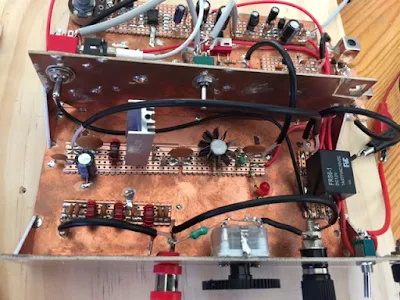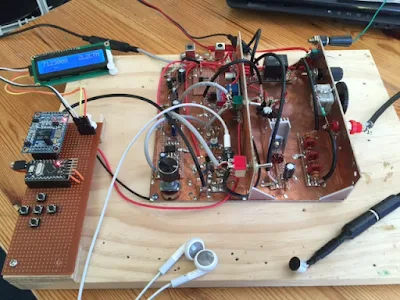New Zealand and Australia seem to produce an amazingly high percentage of the world's double sideband transceivers. Charlie ZL2CTM adds to the count. He took inspiration and circuitry from DSB hams in both countries and produced this beautiful DSB transceiver. It is obviously -- as Charlie notes -- chock full of soul. I definitely identify with his comment about "taming some kind of electro-mechanical machine" and also, of course, with his remark about the feelings that come with putting a homebrew rig on the air. So follow the advice of Charlie! Build a DSB rig and put it on the air! Make this your ham radio resolution for 2016! Give it a go!
Serving the worldwide community of radio-electronic homebrewers. Providing blog support to the SolderSmoke podcast: http://soldersmoke.com
Podcasting since 2005! Listen to Latest SolderSmoke
Monday, January 4, 2016
ZL2CTM's New Zealand Double Sideband Success
New Zealand and Australia seem to produce an amazingly high percentage of the world's double sideband transceivers. Charlie ZL2CTM adds to the count. He took inspiration and circuitry from DSB hams in both countries and produced this beautiful DSB transceiver. It is obviously -- as Charlie notes -- chock full of soul. I definitely identify with his comment about "taming some kind of electro-mechanical machine" and also, of course, with his remark about the feelings that come with putting a homebrew rig on the air. So follow the advice of Charlie! Build a DSB rig and put it on the air! Make this your ham radio resolution for 2016! Give it a go!
Friday, October 28, 2016
Another Great DSB rig from New Zealand
Saturday, July 2, 2022
A Double Sideband Transmitter from France -- F4IET's "Master Robert"
Monday, April 21, 2025
SolderSmoke Podcast #259 FCC ban of DC Receivers. Pete and Stickers, Mouse Knob, MHST. DC RX Update. Dean and SDR RX, Mythbuster Transceiver, Frequency Counter. Bill's Shack -- Suburban Renewal, Boatanchor Removal, DJI Drone . MAILBAG
Video Version: https://www.youtube.com/watch?v=RslKbpBuYDI
Audio Version: http://soldersmoke.com/soldersmoke259.mp3
Reports of FCC action against Direct Conversion receivers. Outrageous! They are going to prosecute Dean and Bill. The 85th harmonic was apparently interfereing with Starlink satellites over Melbourne Australia, Bali, New Zealand's North Island, the UK, Sweden, Holland and Argentina. Who knew?
Here's the question: How many paragraphs of this post did you read before you realized this was an April 1 thing? C'mon, please let us know. Bill falls for one or two every year. This year he believed that Warren Buffet really had bought Tesla. So, don't feel alone. Fess up.
Travelogue: Pete's trip to Los Olivos. DMV Real ID Blues. Going back to San Francisco? Pete, we have some new stickers...
Pete's Bench: MHST progress. Raspberry Pi. VWS. Transceiver. K7TFC's Mouse Knob.
Dean and Bill update on the SolderSmoke Direct Conversion Challenge: 56 receivers built. And 56 is a lot! Info and especially Dean's videos are still up on the Discord server and on YouTube. Not to late to build! All builders should try to encourage at least one other person to build this receiver. In this way, builders become Elmers and homebrewing can spread. Others have already done this -- you can do it too! W4KAC built a second one for a friend. WZ5M built one, helped a friend do a second, and a third one may be on the way. MakeIt Labs in Nashua, NH is responsible for 4 DC receivers. See all the completed receivers here:
https://soldersmoke.blogspot.com/search/label/DC%20RX%20Hall%20of%20Fame
Once you have the receiver going, start the mods! Front panels! Antennas! Better tuning! Si5351s! DSB transmitters! Tell us about your mods.
SHAMELESS COMMERCE DIVISION: Become a Patreon Sponsor! MostlyDIYRF. Buy Amazon stuff through the Amazon link on our blog site. Subscribe to our video YouTube channel.
Dean's Bench: SDR Receiver project. 20 meter Mythbuster build (a thing of beauty). Homebrew Frequency Counter. Balloons!
Bill's Bench: Suburban renewal. New floor, new paint, got rid of a lot of junk. New operating table from Husky. DX-60, DX-40, VF-1, and maybe even the Lafayette HA-600A receiver have to go. Many books and magazines too. Lightening the load! But keeping the DX-100, HQ-100, HT-37 and, of course, the Drake 2-B. Boatanchors station. Beacon operations.
Bought a new DJI Drone, but will use it in the Dominican Republic (not here!). And I got my Drone TRUST Certificate.
Mailbag:
Dave W2DAB doing Manhattan building on the island of Manhattan!
Rich K2GJ (ex WA0CGM) -- Nice ham radio memories of his HT-37. Thanks Rich.
Wes W4JYK -- A VWS DC receiver.
A nice note from Farhan VU2ESE.
Todd K7TFC -- Simple vs. Complex
Paul WA1MAC Gluestick 80 meter QRP
Armand WA1UQO Regen receiver highlighted by AA7EE
Dave AA7EE -- FIGHT BACK AGAINST THE FCC! Build the DC Receiver!
Rogier PA1ZZ Many great videos, including one on Heathkit
Bruce KC1FSZ -- Nominated us for ARRL award. Thanks Bruce.
Bob KD4EBM-- Looking into Polar Modulation. https://qrp-labs.com/qmxp/ssbbeta.html
Peter VK2EMU -- Thought of Peter when I briefly took down the N2CQR sign he made.
Victor HI7S -- 46 km away from my place in the DR. Says I won the lottery... He is right.
Jim KI4THC Got his Extra ticket. Congratulations Jim.
Kirk NT0Z -- On Kits, Hombrew, and the influence of Russian Homebrewers.
Were Russian spies taught how to homebrew their own spy radios?
Thursday, May 23, 2024
Charlie ZL2CTM's New Receiver
Thanks Charlie! Be sure to check out the rest of his YouTube channel: https://www.youtube.com/@CharlieMorrisZL2CTM
Sunday, February 23, 2025
SolderSmoke Direct Conversion Receiver Used in an SSB QSO in New Zealand by ZL1AUN
Aaron ZL1AUN used his homebrew SolderSmoke Direct Conversion receiver in a 40 meter SSB contact with his fellow New Zealand radio amateurs. His transmitter was a modern commercial rig, but his receiver was the Direct Conversion receiver.
I think Aaron's video is an excellent demonstration of how stable and useful this receiver really is.
The next step for many will be the construction alongside the DC receiver of a Double Sideband transmitter. You could make it with only the receiver PTO serving as the common stage. Just build another mixer, a mic amp, and an RF amp with low pass filter. Switch the DC voltage and the antenna from T to R and you will be on the air, on phone, fully homebrew.
Here is an article describing how I did this on 17 meters in the Azores in 2001:
https://www.gadgeteer.us/17METER.HTM
Here is the Doug DeMaw article in CQ magazine that got me started in homebrew DSB:
https://soldersmoke.blogspot.com/2024/04/the-doug-demaw-article-that-got-me-into.html
For more information on this project, and for information on how you could build this receiver see:
Join the discussion - SolderSmoke Discord Server:
Documentation on Hackaday:
https://hackaday.io/project/
SolderSmoke YouTube channel:
https://www.youtube.com/@
Saturday, September 20, 2014
Kiwi Lunchbox Sideband: The Tucker Tin Two
It uses the phasing method of sideband generation. No crystal filters in this one. You need TWO balanced modulators. You have a 90 degree phase shift network for the RF (from the carrier oscillator) and a second 90 degree phase shift network for the AF from the mic amplifier. When you combine the signals from the two balanced modulators -- viola! -- one of the sidebands disappears. The balanced modulators take care of the carrier, and an SSB signal is launched. That is how my old HT-37 works, and similar ideas seem to be at work in modern SDR rigs.
G3TXQ has the complete set of Break-In articles (it includes a VFO):
http://www.karinya.net/g3txq/temp/tucker_tin/
Here is a Canadian article on the rig. A "Tucker Tin" is apparently what the Kiwis call a lunch boxes (shades of Benton Harbor...).
Thanks Pete!
Our book: "SolderSmoke -- Global Adventures in Wireless Electronics" http://soldersmoke.com/book.htm Our coffee mugs, T-Shirts, bumper stickers: http://www.cafepress.com/SolderSmoke Our Book Store: http://astore.amazon.com/contracross-20
Friday, April 28, 2017
An Old but Cool DiFX: The Epiphyte
I've been hearing about this rig for many years. It first appeared in the September 1994 issue of QRPp, the journal of the NORCAL QRP club. A condensed version of that article appeared in SPRAT 81 (Winter 94-95). The designer is Derry Spittle VE7QK from Vancouver, British Columbia.
The name always puzzled me. Here is the explanation: It started with the Neophyte: A very simple direct conversion receiver that many of us built. The Neophyte was mostly an NE602 and an LM386. In the Epiphyte, a crystal filter and a second NE602 were added, turning the Neophytes into a superhet receiver and -- with some additional circuitry -- an SSB transceiver. The Oxford English Dictionary reportedly defines an Epiphyte as "a plant that grows on another plant"(see picture below). The Epiphyte grew out of the Neophyte.
And this plant grew in British Columbia, which seems -- like Australia and New Zealand -- to be fertile ground for simple phone rigs. I'm pretty sure the "Wee Willy" DSB rig also came out of BC, and it may have had a similar purpose: allowing for portable contact with the BC Public Service Net on 75 Meters.
There are many features of the Epiphyte that I like: There is a simple 455 kHz filter and a ceramic resonator BFO/Carrier oscillator. The original design featured a VXO-like circuit using a ceramic resonator at 4.19 MHz. And it ran off AA batteries (as did the NE602 DSB rig I took to the Dominican Republic).
Unlike my NE602 rig, the Epiphyte made an artful use of the fact that NE602's can be set up to have TWO inputs and TWO outputs. Where I used DPDT relays to switch inputs and outputs from both NE602s, OM Spittle left all the inputs and outputs connected, and simply switched the VFO and BFO signals. Ingenious.
There were updates and improvements. The Epiphyte 2 and 3 featured increased power out (5 watts vs. 1 Watt). Version 3 has an IRF-510 in the final, driven by a CA3020A chip. That chip is capable of 70 db gain. Wow.
In 1996 NORCAL and G-QRP donated 50 EP-2 kits to radio amateurs in third world countries. Very nice.
In 2000 NORCAL did a kit of the EP-3 -- it sold out in 24 hours. Here is a nice article on the EP-3:
http://www.norcalqrp.org/files/Epiphyte3Mnl.pdf
And above we have a video from Japan of an EP-3 in action.















